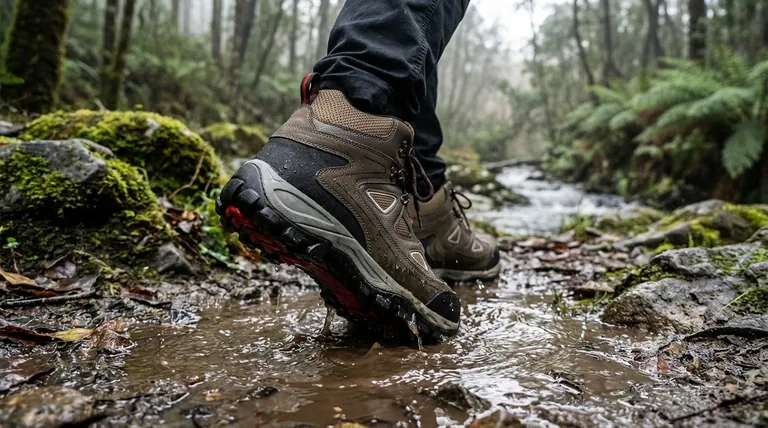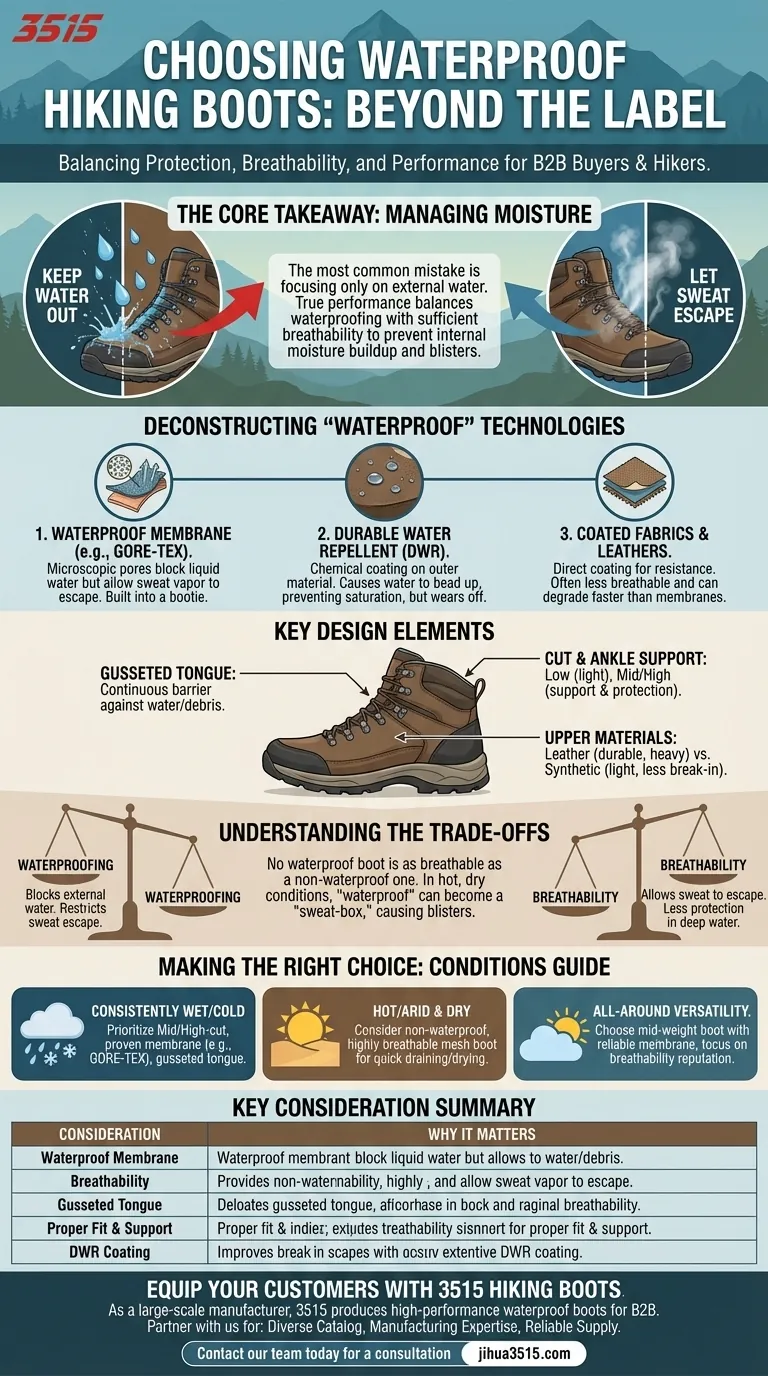Okay, so I've got a user with a specific need: finding the best waterproof hiking boots. They're not just looking for "waterproof," they want optimal performance and comfort on the trail. I need to guide them, providing objective, expert advice. My goal isn't just to list features; it's to help them make an informed decision that truly enhances their hiking experience and, most importantly, keeps their feet dry.
2. Analyzing the References:
I see a lot of information here, but it's crucial to distill it to the core elements. Waterproofing technology is the most important: I need to explain the concepts around membranes (like GORE-TEX), coated fabrics, and DWR treatments. Then, boot construction is key – the tongue design for complete coverage, ankle support, material quality. The user's specific context - climate, terrain - must guide the choices, and breathability will be the critical tradeoff. Finally, proper fit and traction for safety and comfort are paramount.
3. Synthesis and Structure:
- Opening Hook:
- I'll start by emphasizing that choosing the right boot is about more than just a waterproof label. I need to immediately highlight that the key is effective moisture management.
- Core Takeaway:
- This will focus on the most common error: focusing only on keeping water out. I'll frame it around balancing waterproofing with breathability.
- Main Body:
- I will break down the crucial waterproofing technologies: the membrane and how it works; treated leathers and coated fabrics; and the DWR coating's role. I'll explain critical design features like the gusseted tongue and upper material options. The crucial trade-offs, particularly between waterproofing and breathability, will get top billing.
- I'll explain how focusing on fit, comfort, and good traction on the appropriate terrain make it all worthwhile.
- Concluding Section:
- I'll make it actionable, offering distinct advice on different user needs. I'll end with a final sentence that empowers the user to make a choice that truly fits them.
I'm confident this approach will provide a complete, expert answer for any hiking enthusiast. Choosing the right waterproof hiking boot requires looking beyond a simple "waterproof" label to understand the technology, design, and inherent trade-offs. The most critical considerations are the type of waterproofing system used, the boot's breathability, the overall construction relative to your intended terrain, and, most importantly, a proper fit.
The most common mistake is focusing solely on keeping external water out. The best choice balances robust waterproofing with sufficient breathability to manage internal moisture (sweat), ensuring your feet stay truly dry and comfortable from the inside out.

Deconstructing "Waterproof": The Core Technologies
To make an informed choice, you must first understand how a boot achieves its water resistance. The method used directly impacts its performance, durability, and comfort.
The Waterproof Membrane
This is the industry standard for high-performance hiking boots. A waterproof, breathable membrane (the most famous brand being GORE-TEX) is a microscopic layer with pores too small for liquid water to pass through, but large enough for water vapor (sweat) to escape.
This membrane is typically built into a sock-like "bootie" that sits between the boot's outer material and the inner lining, providing a complete, reliable barrier.
The Role of DWR
Durable Water Repellent (DWR) is a chemical coating applied to the exterior fabric or leather. It causes water to bead up and roll off the surface.
DWR is not what makes a boot truly waterproof; the internal membrane is. However, a functioning DWR is critical because it prevents the outer material from becoming saturated, which would impair the membrane's ability to breathe. This coating wears off over time and must be reapplied.
Coated Fabrics and Leathers
Some boots achieve water resistance through treated leathers or fabrics with a waterproof coating applied directly to them. This method is often found in less expensive boots.
While effective initially, these coatings can be less breathable than a dedicated membrane and their waterproof integrity can degrade more quickly, especially at flex points.
Key Elements of Boot Design
Waterproofing technology is only one part of the equation. The physical construction of the boot is essential for keeping water out and providing support.
The Gusseted Tongue
This is a non-negotiable feature for any serious waterproof boot. A gusseted tongue is attached to the boot's upper along the sides, creating a continuous barrier that prevents water, dirt, and debris from entering through the lace area.
Cut and Ankle Support
The height of the boot affects both protection and support.
- Low-cut boots are lighter but offer minimal protection from puddles or stream crossings.
- Mid-cut and High-cut boots provide superior ankle support and create a higher barrier, keeping your feet dry in deeper water and protecting you from trail hazards.
Upper Materials
The choice between leather and synthetic materials impacts durability, weight, and break-in time. Full-grain leather is exceptionally durable but heavier, while synthetic uppers are lighter and require less breaking-in but may offer less long-term resilience.
Understanding the Trade-offs
There is no perfect, one-size-fits-all solution. Every design choice involves a compromise, and understanding these is key to avoiding disappointment.
The Breathability Compromise
This is the most critical trade-off. No waterproof boot is as breathable as a non-waterproof one. The membrane that blocks water from coming in inevitably restricts the rate at which sweat can escape.
When "Waterproof" Works Against You
In hot, dry climates or for hikers with exceptionally sweaty feet, a waterproof boot can become a "sweat-box." Trapped moisture can soften the skin and lead to blisters just as easily as external water can.
In these conditions, a highly breathable, non-waterproof boot that drains well and dries quickly is often the superior choice.
Durability and Maintenance
Waterproof membranes can be damaged or develop leaks over time, particularly in high-flex areas. Furthermore, the external DWR coating will always require periodic cleaning and reapplication to maintain the boot's performance and breathability.
Making the Right Choice for Your Hike
Your decision should be guided by the conditions you most frequently encounter.
- If your primary focus is hiking in consistently wet, muddy, or snowy conditions: Prioritize a mid or high-cut boot with a proven waterproof membrane like GORE-TEX and a gusseted tongue.
- If your primary focus is hiking in hot, arid climates with occasional water crossings: Consider a non-waterproof, highly breathable mesh boot that is designed to drain and dry quickly.
- If your primary focus is all-around versatility for varied conditions: Choose a mid-weight boot with a reliable membrane, but pay close attention to its reputation for breathability.
Ultimately, the right boot is one that fits perfectly, matches your specific environment, and manages moisture effectively from both the inside and the out.
Summary Table:
| Key Consideration | Why It Matters |
|---|---|
| Waterproof Membrane (e.g., GORE-TEX) | Creates a reliable barrier against external water while allowing sweat vapor to escape. |
| Breathability | Crucial for managing internal moisture; a lack of it can lead to sweaty feet and blisters. |
| Gusseted Tongue | Prevents water, dirt, and debris from entering through the lace area. |
| Proper Fit & Ankle Support | Ensures comfort, stability, and protection based on the terrain (low, mid, or high-cut). |
| DWR Coating | Causes water to bead up on the outer material, preventing saturation and maintaining breathability. |
Ready to Equip Your Customers with the Perfect Hiking Boots?
As a large-scale manufacturer, 3515 produces a comprehensive range of high-performance waterproof hiking boots for distributors, brand owners, and bulk clients. Our production capabilities encompass all types of outdoor footwear, ensuring durability, comfort, and advanced waterproofing technology.
Partner with us to:
- Access a diverse catalog of hiking boots designed for various terrains and climates.
- Benefit from our manufacturing expertise to create custom or private-label footwear.
- Ensure reliable supply and competitive pricing for your bulk orders.
Let's discuss your specific needs and how we can support your business growth.
Contact our team today for a consultation
Visual Guide

Related Products
- Safety Footwear Wholesale Manufacturer for Custom OEM/ODM Production
- High Performance Fire-Retardant Waterproof Safety Boots
- Premium Wholesale Waterproof Safety Boots High Performance Protection for Industrial Markets
- Factory Direct Wholesale Rain Boots Durable Waterproof & Fully Customizable
- Premium Flame-Retardant Waterproof Safety Boots and Shoes
People Also Ask
- Is it normal to wear shoes in the house? A Guide to Hygiene, Comfort & Culture
- How do safety shoes contribute to cost savings for companies? A Strategic Investment in Risk and Cost Management
- What cultural and environmental considerations are tied to wearing shoes indoors? Balance Hygiene, Tradition, and Foot Health
- Do snake bite boots work? Your Ultimate Guide to Effective Snake Bite Protection
- What are the differences between steel toe, composite toe, and alloy toe Wellington boots? Choose the Right Safety Toe for Your Job



















